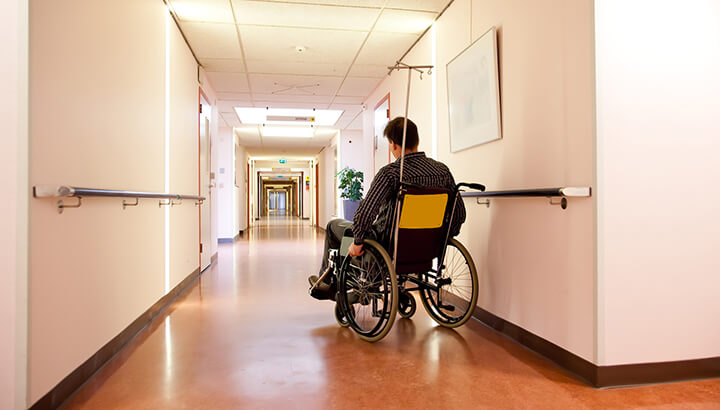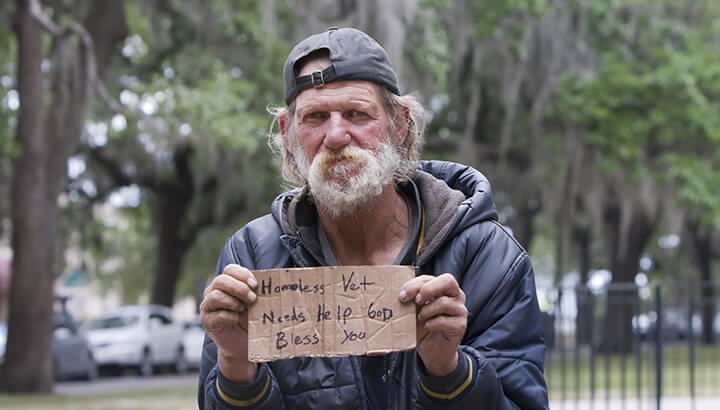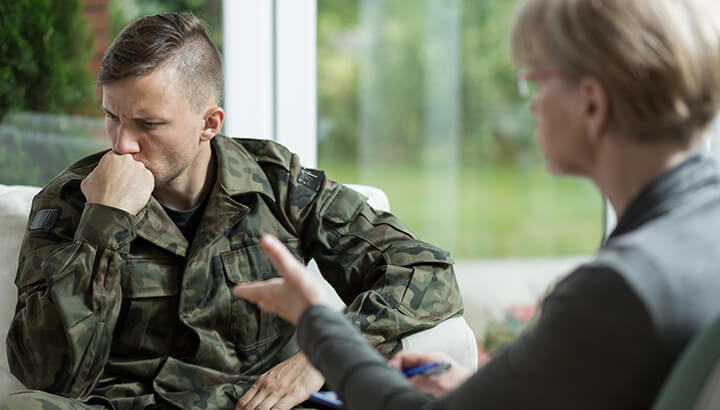
Roughly 20 veterans a day commit suicide. Meanwhile, thousands more are left waiting for care they never receive. Men and women serve their country, yet return home to unemployment and homelessness. Thousands of applications for veteran benefits are hopelessly backlogged and the condition of most VA hospitals is an absolute disgrace. So, why is the system broken and what can we do to fix it?
A broken system
The population in the United States is just over 324 million people. According to the most recent statistics from the U.S. Census, 18.8 million of these people are veterans. That’s almost double the amount of people that currently reside in the state of Michigan. And after sacrificing their lives to serve America, veterans return home to find themselves suffering from mental health issues and substance abuse. They have nowhere to live and nowhere to turn. Meanwhile, the number of vets who commit suicide each year is staggering.
Appalling conditions in VA hospitals

CNN recently reported that in February of 2009, the Veterans Affairs (VA) contacted over 6,000 patients from Alvin C. York VA Medical Center in Murfreesboro, Tennessee. Unknowingly, vets may have been exposed to infectious diseases at the clinic due to contaminated endoscopic equipment.
That same month, the Charlie Norwood VA Medical Center in Augusta, Georgia also contacted over 1,200 people. They too may have been treated with contaminated equipment. One month later, the VA sent letters to over 3,000 people. It seems those who had colonoscopies at VA facilities in Miami may have been exposed to hepatitis and HIV. Hospital officials said that a review of safety procedures found that tubing used in endoscopic procedures were rinsed but not disinfected.
Shortly thereafter, the VA notified over 1,800 veterans treated at the John Cochran VA hospital in St. Louis that they may have been exposed to infectious diseases during dental procedures. Then in 2011, nine Ohio vets tested positive for hepatitis after routine dental work at a VA clinic in Dayton, Ohio. A dentist at the VA medical center admitted he never washed his hands or even changed gloves between patients for 18 years.
Unfortunately, it doesn’t end there. VA medical centers and hospitals throughout the U.S. are meant to protect veterans who depend on them for their health care. Instead, their lives are continually placed at risk. But, are all these VA experiences the norm? Maybe — maybe not. Social media and news outlets often report the “worst of worst” scenarios. But are we painting an inaccurate picture? Well, the facts remain. Perhaps by exposing the flaws, only then can a broken system be fixed and our veterans get the treatment they need and deserve.
How to help hospital conditions
According to the Official Blog of the U.S. Department of Veterans Affairs, ex-marine Tim Hudak tells veterans (or anyone who advocates on behalf of a veteran) to take matters into their own hands and speak with a patient advocate.
“Every facility has quarterly town hall meetings that you can attend to speak with the leadership,” says Hudak. “They hold these meetings because they want to hear your feedback. You can also speak with a patient advocate about anything.” Contact your primary healthcare team via My HealtheVet.
Eleven percent of all homeless people in the U.S. are veterans

Homelessness is another problem that plagues our vets. The National Coalition for Homeless Veterans (NCHV) reports that homeless veterans are mainly male, with approximately nine percent being female. The majority of homeless vets are single, live in urban areas and suffer from mental illness. They also suffer from alcoholism, substance abuse issues or co-occurring disorders.
America’s homeless veterans have served in World War II, the Korean War, Cold War, Vietnam War, Grenada, Panama, Lebanon, Persian Gulf War, Afghanistan and Iraq (OEF/OIF) and the military’s anti-drug cultivation efforts in South America, says the NCHC.
Why are so many veterans homeless?
The facts that surround homelessness are multifaceted. Homeless vets are generally the result of an extreme shortage of affordable housing and livable income. The lack of health care also plays a significant role. A large number of displaced and at-risk veterans live with post-traumatic stress disorder (PTSD) and substance abuse. These conditions are compounded by a lack of family and social support networks, says the NCHV.
In addition, military occupations and training are not always transferable to the civilian workforce. Therefore, some vets are at a disadvantage when competing with the non-veteran workforce.
How to help homeless veterans
What homeless vets need is secure, safe, clean housing that offers a supportive environment free of drugs and alcohol. So, what can we do to help? Participate in local homeless coalitions — there’s probably one in your community. If not, then contact your elected officials or speak with your mayor’s office.
Maybe it’s time to bring people together in your community and discuss what is being done for homeless veterans. Additionally, you can make a donation to your local homeless veteran service provider.
Each day, 18 to 22 veterans commit suicide

The suicide rate among veterans is disturbing. In fact, the number of veterans who commit suicide each year is greater than the total number of all U.S. war deaths in over 10 years of fighting in Iraq and Afghanistan. In 2014, the latest year available, more than 7,400 veterans took their own lives, according to Military Times. Veteran suicides account for 18 percent of all suicides in America. In fact, a new survey of post-9/11 veterans suggests an increase over a previous study in the number of veterans who contemplated suicide since joining the service.
There’s also a belief among this group that the Veterans Affairs and Defense departments aren’t adequately addressing mental health injuries or doing enough to address the problem. These numbers are troubling and suggest a significant mental health risk for those who served in the military — though specifics are unclear. Researchers found that the risk of suicide for veterans is 21 percent higher than the risk of civilian suicide. And the problem seems to be worse among female veterans, whose rates in suicide between 2001 to 2014 rose over 85 percent, compared to a 40 percent rise for civilian women.
So, why are suicide rates higher for veterans than for civilians? An Israeli study points to PTSD as a factor of suicide among veterans. The study suggests that the traumatic memories of war play a significant role in the risk of suicide. That’s probably an understatement, considering those who have returned from battle come back to a world where the average person cannot possibly comprehend what they have experienced. That’s where programs like the Wounded Warrior Project and Iraq and Afghanistan Veterans of America (IAVA) step in to help.
Wounded Warrior Project
Over two million men and women have deployed around the world to fight for America. The number of vets who return with PTSD and traumatic brain injury (TBI) is staggering, suggests the Warrior Care Network, who has partnered with the Wounded Warrior Project. Also partnered are four national academic medical centers of excellence: Emory Healthcare, Massachusetts General Hospital, Rush University Medical Center and UCLA Health. Today, more than ever, it’s becoming increasingly difficult for vets to access timely and effective mental health treatment for PTSD, TBI and other invisible wounds.
In cooperation with the Department of Veterans Affairs, this program connects thousands of veterans with world-class care. In fact, all treatment is provided at no cost to the veteran. Additionally, travel is also provided at no cost to vets and their family members. For more information, call 877-TEAM-WWP (832-6997).
IAVA
IAVA is a post-9/11 veteran support and empowerment organization. They address critical issues that most new vets and their families face. These include mental health injuries, a stretched VA system, inadequate health care for female veterans and GI Bill educational benefits. IAVA provides one-on-one support and referral services. They help vets transition between deployment and home life.
To date, IAVA has helped veterans use their GI Bill to pursue education, find doctors and legal support. They have also helped vets access emergency housing, financial assistance and more. Services are free and confidential. And they’re open to veterans of all eras and their families.
To connect with a veteran transition manager at the Rapid Response Referral Program email transition@iava.org or call: 1-855-91-RAPID (1-855-917-2743). If you are experiencing a crisis, call the Veterans Crisis Line at 1-800-273-8255 and press 1. You can also text 838255.
Extreme distress and emotional pain
People who take their lives don’t want to die, they just want to stop hurting, says Helpguide.org. And, contrary to popular belief, most suicidal people are not psychotic or insane. They’re grief-stricken, depressed or in extreme distress and emotional pain. But these signs alone are not necessarily signs of mental illness. Even someone who is severely depressed has mixed feelings about death. They waver until the very last moment between wanting to live and wanting to die.
Suicidal warning signs
- Talking about suicide in ways such as “If I see you again…” and “I’d be better off dead.”
- Seeking out lethal means such as guns, pills, knives or any other objects that could be used in a suicide attempt.
- Preoccupation with death, dying or violence.
- Loss of hopelessness, feelings of being trapped and believing that things will never get better.
- Self-loathing, self-hatred and feelings of worthlessness, guilt and shame. Additionally, feeling like a burden, like saying, “Everyone would be better off without me.”
- Getting their affairs in order by preparing a will, giving away prized possessions and planning arrangements for the family.
- Saying goodbye to friends and family as if they may never see them again.
- Withdrawing from friends and family and increasing social isolation.
- Self-destructive behavior by increasing alcohol or drug use, reckless driving and unsafe sex. In addition, taking unnecessary risks as if they have a “death wish.”
- A sudden sense of calm and happiness after being extremely depressed. This can mean that they’ve decided to attempt suicide.
Although helping a suicidal person is difficult, remember that the assistance you provide could save someone’s life. Just because a suicidal person doesn’t ask for help, it doesn’t mean they don’t want help. If you think someone may be suicidal, you should directly ask him or her, suggests The U.S. Department Of Veterans Affairs. Asking someone if they are suicidal will not put the idea in their head, says the VA. Offering a helping hand to someone who is suicidal makes it easier for them to make the initial call to a mental health professional and obtain treatment.
How to help save a life
Take suicidal comments very seriously. If someone is telling you that they are thinking of suicide, believe them. Suicide.org says to stay calm and try not to act shocked. Acting shocked could further distress a suicidal person. Call 911, 1-800-SUICIDE or 1-800-273-TALK. Remember, a suicidal person needs professional help from a qualified mental health clinician immediately.
If someone you know is in crisis and needs help, listen intently and comfort them with words of encouragement. Don’t judge or invalidate his or her feeling. They may be suffering from a chemical imbalance in the brain and therefore could not possibly think clearly. Let that person know that you are highly concerned. And if the person has a high-risk for suicide, don’t leave them alone until professional help arrives. For anyone struggling with suicide, contact The National Suicide Prevention Lifeline at 1-800-273-8255.
In Canada, contact the Canadian Association for Suicide Prevention or call Mental Health resources for Canadian Armed Forces members at 1-800-268-7708. Families may call at 1-800-866-4546.
We need to stand by our vets
Supporting veterans is paramount for those who return disabled, traumatized and injured. You can help a vet in need by:
- Volunteering to give him or her a ride to and from their appointments. A disabled veteran may struggle to get to appointments.
- Sponsoring a companion dog for vets with PTSD. Puppies Behind Bars is a program whereby prisoners train companion dogs for veterans with PTSD.
- Helping to build a home for severely injured veterans, since they’ll need a place to live that is equipped for their physical disabilities. Building Homes for Heroes helps vets live independently by building specially modified homes.
Most of us may never serve in the military. Yet, as the veteran population continues to grow, so do the problems. And, as a nation, we need to stand by our veterans and help solve these problems. If nothing else, simply say thank you. Expressing gratitude to a vet can make a huge impact on someone who may have never heard the words “thank you” for their service. If you know a vet or see someone in a military uniform, support them just by saying you appreciate their service. You’ll make their day and probably yours.
— Katherine Marko

